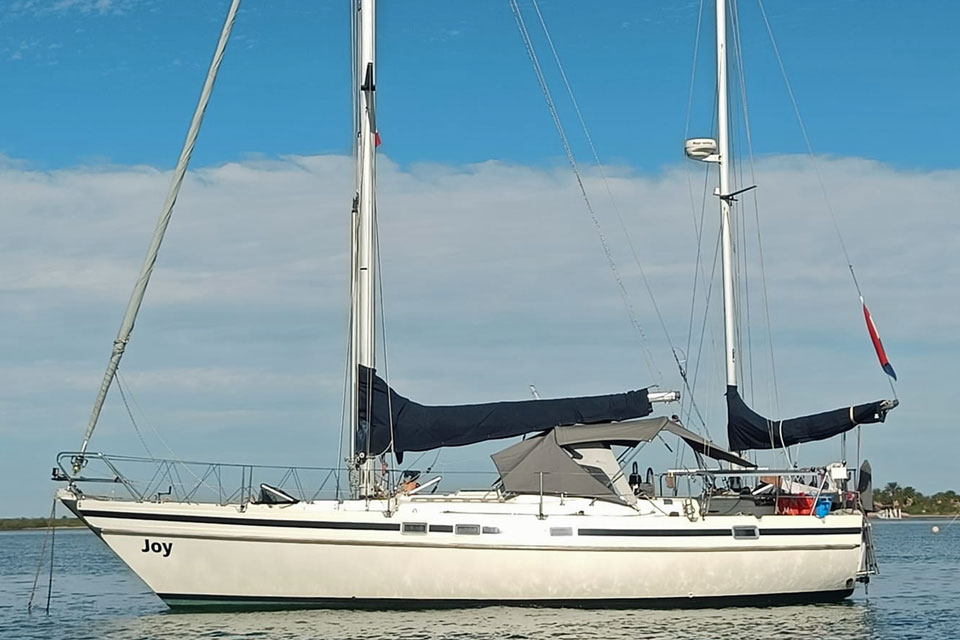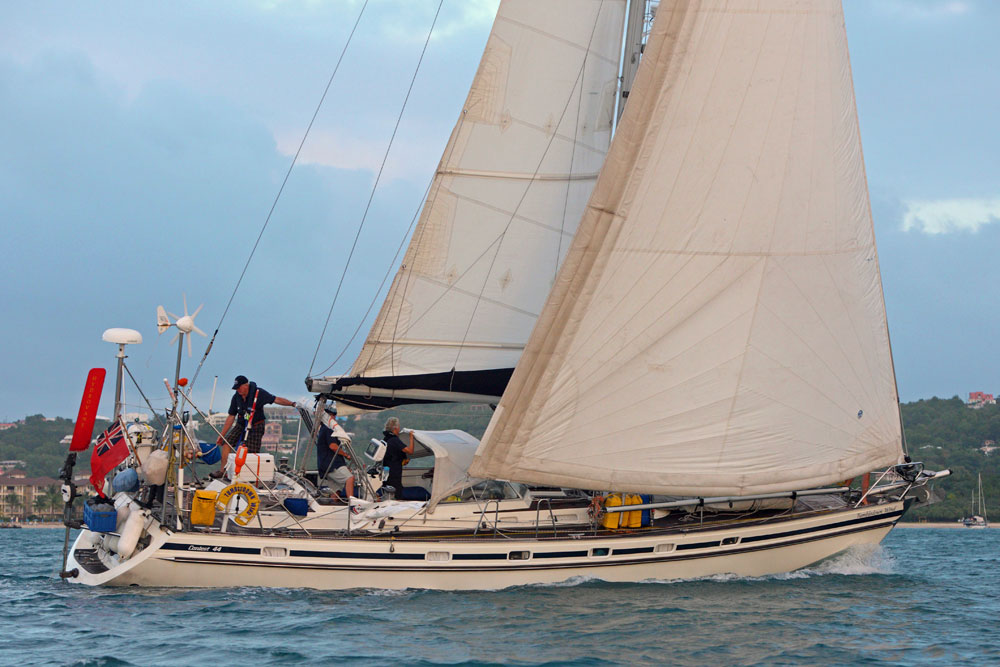- Home
- Cruising Yachts 35' to 40'
- Contest 38S Sailboat
The Contest 38S Sailboat
Specs & Key Performance Indicators
The Contest 38s sailboat, a heavy-displacement centre-cockpit cruiser, was designed by the Dutch naval architect Dick Zaal and was built by Contest Yachts at their shipyard at Medemblik in the Netherlands.
 A ketch version of the Contest 38S
A ketch version of the Contest 38SThe Contest 38S is a development of the Contest 38. Whilst there are many similarities there are some key differences:
- Rig: The Contest 38 has a traditional masthead sloop rig, while the 38s is also available as either a ketch or a sloop.
- Interior Layout: The 38s has a center cockpit design, providing a spacious aft cabin with en suite facilities, whereas the 38 has an aft cockpit layout.
- Keel Options: The Contest 38S typically features an optional shallow, winged keel, while the 38 has a fin and balanced skeg rudder.
Published Specification for the Contest 38S Sailboat
Keel & Rudder Configuration: Fin keel with spade rudder*
Hull Material: Fiberglass
Length Overall: 11.95m (39'2")
Waterline Length: 9.50m (31'2")
Beam: 3.90m (12'9")
Draft: 1.70m (5'7")**
Rig Type: Masthead sloop***
Displacement: 8,010kg (17,659lb)
Ballast: 3,400kg (7,496lb)
Designer: Dick Zaal
Builder: Contest Yachts (Conyplex)
Year First Built: 1984
Year Last Built: 1994
Number Built: Approximately 105 units
* Also available with a shallow wing keel
** Draft for wing keel version: 1.4m (4'6")
*** Also available as a ketch, as shown in pic above.
Published Design Ratios for the Contest 38S Sailboat
The Key Performance Indicators (KPIs)
- With a Sail Area/Displacement Ratio of 12.0, the Contest 38s is considered underpowered. This suggests that the boat may not perform optimally in lighter wind conditions and may require more wind to achieve good sailing speeds. This ratio indicates a more leisurely performer compared to high-performance racers, making it more suited for relaxed cruising rather than competitive sailing.
- A Ballast/Displacement Ratio* of 39.4 is fairly close to 40, implying that the boat has a decent amount of stiffness and stability. However, since it doesn't meet or exceed 40, it is slightly less stiff than boats that do, which might affect its ability to stand up to stronger winds without heeling excessively. The limitation of this ratio is that it doesn't consider the placement of the ballast. For example, if the ballast is located higher up in the keel rather than in a bulb at the bottom, the boat would be less stiff and more prone to heeling.
- With a Displacement/Length Ratio of 324, the Contest 38s falls into the heavy displacement category. This suggests that the boat is relatively heavy compared to its length, implying sturdiness and solidity. Heavy displacement boats are generally slower but can handle rough sea conditions more comfortably, making the Contest 38s more suited for heavy weather and longer offshore passages.
- The Comfort Ratio* of 3.0 indicates that the Contest 38s has the motion associated with moderate bluewater cruising boats. This ratio suggests that the boat should provide a relatively stable and comfortable experience for the crew in a variety of sea conditions. However, it should be noted that Ted Brewer's Comfort Ratio tends to favour heavier displacement boats with narrow beams and long overhangs, which may not align with modern boat designs that can still offer comfortable rides due to advanced design and technology.
- A Capsize Screening Formula value of 1.8 is well below 2.0, suggesting that the Contest 38s is theoretically capable of handling bluewater (ocean) passages with a lower risk of capsizing. This low value is favorable and implies good stability in rough seas.
In summary, the Contest 38s is theoretically underpowered for high-performance sailing with a more leisurely and steady cruising profile suited for offshore passages. It offers moderate comfort and stability, making it a dependable choice for bluewater cruising rather than racing.
However...
- *Ballast/Displacement Ratio Limitation: This ratio doesn't consider the distribution of ballast within the keel. A boat with low-down ballast (e.g., in a bulb keel) will be stiffer and more stable than one with ballast positioned higher up, even if they have the same B/D ratio.
- **Comfort Ratio Bias: Ted Brewer's Comfort Ratio favours traditional, heavy displacement boats with narrow beams, which means modern light-displacement, beamy cruisers with plumb bows may score poorly despite offering significant comfort through their design innovations. Consequently this metric should be used with caution when comparing modern sailboats to older designs.
In conclusion, while these ratios provide a useful guide to the Contest 38s' theoretical performance and comfort, they are indeed theoretical and should be considered alongside other factors like actual sailing trials, the specific design of the keel, and the boat's overall build quality.
Here's how to calculate the KPIs yourself - without having to wrestle with the mathematics...
Other sailboats in the Contest range include:
This article was written with the assistance of Gemini, a large language model developed by Google. Gemini was used to gather information, summarize research findings, and provide suggestions for the content and structure of the article.
Recent Articles
-
Hans Christian 43: Classic Bluewater Cruiser & Liveaboard Sailboat
Dec 10, 25 04:37 AM
Explore the Hans Christian 43: a legendary heavy-displacement, long-keel sailboat. Read our in-depth review of its specs, design ratios, and suitability for offshore cruising and living aboard. -
Planning Your Sailboat Liveaboard Lifestyle: An Ocean Sailor's Guide
Dec 06, 25 05:18 AM
Seasoned sailors share their methodical risk analysis for planning a secure Sailboat Liveaboard Lifestyle, covering financial, property, and relationship risks. -
Marine Cabin Heaters: The Expert’s Guide to Comfort & Safety at Sea
Dec 05, 25 06:52 AM
Choose the best Marine Cabin Heaters for your vessel. Expert advice on diesel, paraffin, and hot water systems for year-round cruising comfort.













